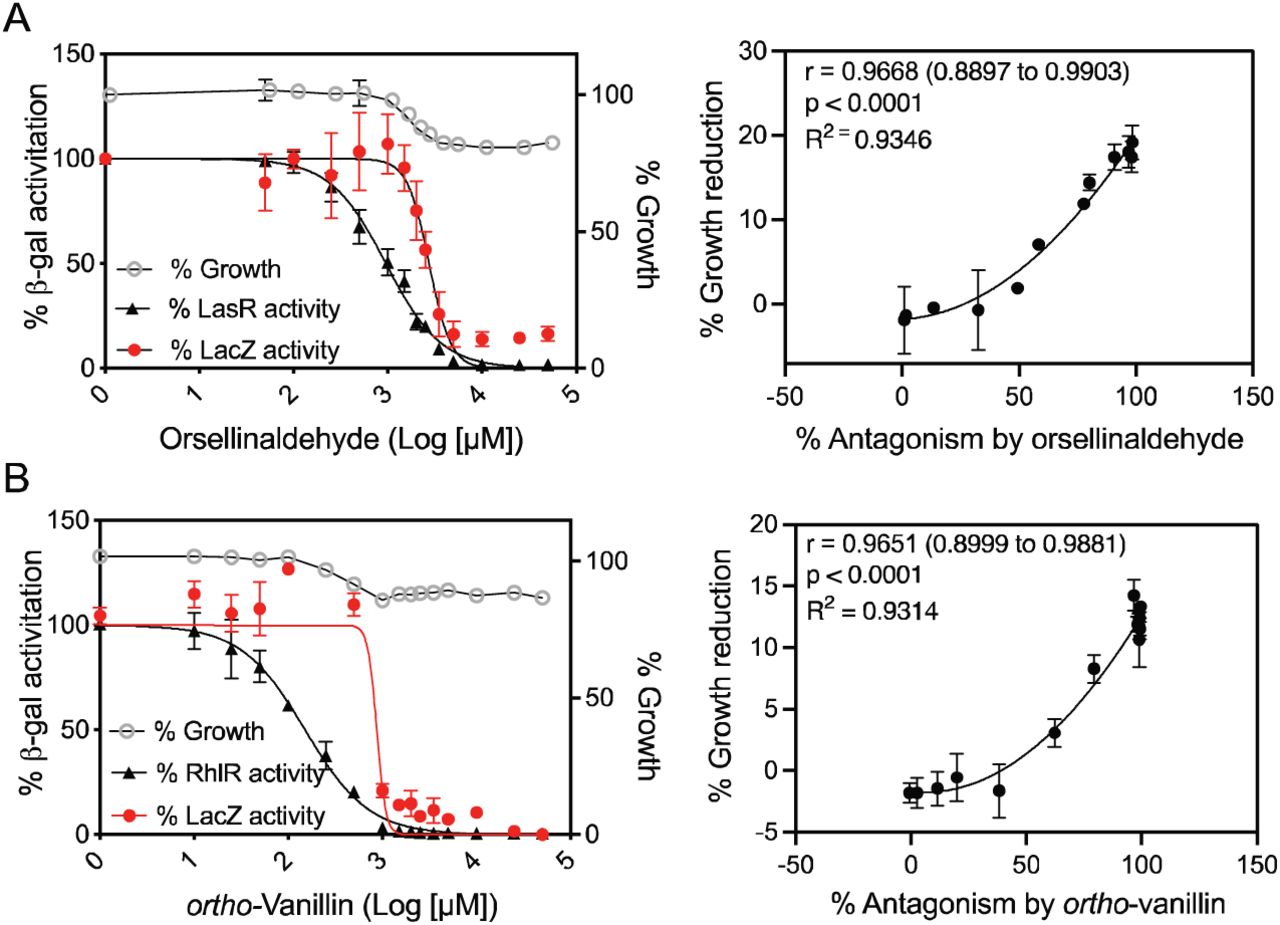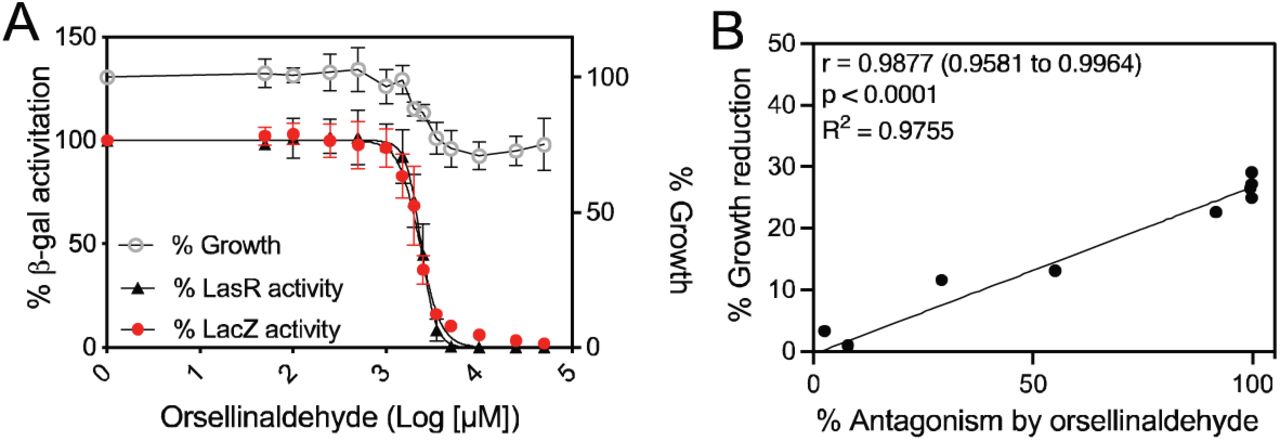Characterization of natural product inhibitors of quorum sensing in Pseudomonas aeruginosa reveals competitive inhibition of RhlR by ortho-vanillin
Posted on: 22 May 2024
Preprint posted on 24 February 2024
Ortho-Vanillin: A promising and potential quorum sensing inhibitor
Selected by UofA IMB565, Likitha Mudigonda, Rishivanthi Jayalakshmi SrinivasanCategories: microbiology
Summary
Quorum sensing (QS) is a vital cell-cell communication mechanism among bacteria, enabling them to coordinate behaviors based on population density. This preprint explores how certain compounds can interfere with quorum sensing, particularly benzaldehyde derivatives because it demonstrated the ability to act as a competitive inhibitor of RhlR, in Pseudomonas aeruginosa, which is notorious for causing difficult-to-treat infections.
The study evaluates the activity of various benzaldehyde derivatives using heterologous reporters of P. aeruginosa‘s QS receptors, LasR and RhlR. It investigates their potential to antagonize the activation of these receptors without causing toxicity. The findings shed light on the molecular mechanisms underlying the action of benzaldehyde derivatives in QS modulation. Specifically, ortho-vanillin is shown to competitively inhibit RhlR, while its interaction with LasR appears to be non-competitive. This distinction suggests that ortho-vanillin may offer a versatile platform for designing QS inhibitors with improved specificity and potency.
Background
Pseudomonas aeruginosa is a ubiquitous Gram-negative bacterium known for its remarkable adaptability and versatility in various environments and the use of quorum sensing for its communication. The quorum sensing (QS) mechanism in P. aeruginosa encompasses two integrated pathways governed by acyl-homoserine lactone signals, alongside a third system utilizing quinolone signals. These interconnected QS circuits collectively oversee the transcriptional activation of numerous genes, a substantial portion of which are associated with the expression of virulence factors (1). These gram-negative bacteria use a specific type of autoinducers: the acyl-homoserine lactones (AHLs)(4). These AHLs consist of a lactone ring coupled with an aliphatic acyl chain that varies in length and structural modifications. Research on Pseudomonas aeruginosa’s quorum sensing has provided significant insights into the fundamental molecular and biochemical mechanisms governing this regulatory system, as well as into the social behavior of bacteria and its implications for the pathogen’s virulence (2,3).
Cinnamon essential oils owe their broad antimicrobial properties to cinnamaldehyde, a compound widely recognized as safe (6). Previous studies highlight its effectiveness in hindering biofilm formation in various clinical pathogens, including Escherichia coli and Pseudomonas aeruginosa (5). Additionally, pyran derivatives like 2- amino- 4- (2,6-dichlorophenyl)- 3- cyano- 5- oxo- 4H,5H- pyrano [3,2c]chromene show promise in combating biofilm formation in S. aureus and P. aeruginosa, as evidenced in animal infection models (7). This study sheds light on how benzaldehyde substances can disrupt Pseudomonas aeruginosa‘s messaging system.
Key findings
Identification of Ortho-Vanillin as an RhlR Antagonist
Researchers used silico docking studies and experimental validation to identify ortho-vanillin as an antagonist of E. coli RhlR reporter strains. RhlR is a key transcriptional regulator involved in quorum sensing, responding to N-butanoyl-L-homoserine lactone (C4-HSL) signals to control gene expression in Pseudomonas aeruginosa. Specifically, ortho-vanillin was found to effectively inhibit RhlR-regulated gene expression at concentrations below 500 μM. Figure 6 displays the activities of orsellinaldehyde and ortho-vanillin with E. coli RhlR and constitutive reporters, providing dose-response curves for both compounds in competition with C4-HSL in cultures of E. coli. The figure also features data on the potency of ortho-vanillin in inhibiting RhlR-dependent gene expression, which supports its identification as an antagonist of RhlR.
Mechanism and Specificity of Ortho-Vanillin as an Antagonist
Ortho-vanillin’s potency diminished when competing against C4-HSL at varying concentrations. Comparing ortho-vanillin’s efficacy against LasR and RhlR, researchers found it to be more effective against RhlR, attributed to structural differences in ligands and receptors.

Orsellinaldehyde as an Antagonist of LasR
Orsellinaldehyde demonstrated its potential as an antagonist of LasR, another important transcriptional regulator involved in coordinating virulence gene expression through quorum sensing. LasR works alongside LasI to detect and respond to autoinducer signaling molecules like N-3-oxo-dodecanoyl-L-homoserine lactone (3OC12-HSL). Orsellinaldehyde exhibited dose-dependent growth inhibition and competed with 3OC12-HSL, suggesting it functions as a LasR antagonist. Figure 3 presents the dose-response curves of Orsellinaldehyde in competition with 100 nM 3OC12-HSL in cultures of E. coli with arabinose-inducible LasR and a LasR-dependent lasI-lacZ reporter (black line) or of E. coli with a constitutive aphA-3-lacZ reporter (red line). The figure illustrates the percentage of growth reduction versus the percentage inhibition of the lasI-lacZ reporter. These findings suggest that Orsellinaldehyde has the potential to be developed as a therapeutic agent targeting LasR-mediated signaling pathways.

Conclusion
The study underscores the criticality of acyl tail functionality in benzaldehyde derivatives for the effective antagonism of LasR. The results demonstrated that benzaldehyde derivatives lacking acyl tails exhibited limited antagonistic activity against LasR. Overall, the paper contributes to our understanding of QS inhibition mechanisms and identifies ortho-vanillin as a promising compound for the development of novel QS inhibitors. The investigation probed the actual biofilm inhibition capabilities of these benzaldehyde derivatives, providing novel insights into their specific antagonistic activities against LasR and RhlR. Notably, ortho-vanillin’s efficacy in antagonizing these receptors suggests promising avenues for the design of targeted anti-virulence therapeutics. Furthermore, it sets the foundation for future research aimed at designing potent and selective inhibitors targeting QS pathways in P. aeruginosa and other related bacteria.
What we like about this preprint
This preprint is noteworthy for its comprehensive investigation into benzaldehyde derivatives as potential antagonists of Pseudomonas aeruginosa quorum sensing receptors, LasR, and RhlR. The study’s use of computational modeling and experimental assays in Escherichia coli reporter strains to elucidate the mechanisms and efficacy of these compounds is particularly intriguing. The discovery of ortho-vanillin’s dual activity, which includes non-competitive inhibition of LasR and competitive inhibition of RhlR, represents a significant advancement in understanding quorum sensing modulation.
Additionally, the study’s focus on structural determinants of antagonistic activity, particularly the role of acyl tail functionality, provides valuable insights for the development of future therapeutic interventions. Overall, the integration of diverse methodologies and the elucidation of distinct inhibition mechanisms make this preprint a notable contribution to the field of quorum sensing research.
Questions for the authors:
- How do you envision the potential applications of ortho-vanillin and its derivatives as QS inhibitors beyond the laboratory?
- What would the next steps of your research be after these findings, and what additional experiments do you plan to conduct to confirm your results?
- Regarding a larger picture of battling bacterial infections and addressing antibiotic resistance, how do you view the function of ortho-vanillin and related compounds?
Future directions
- Validating ortho-vanillin’s efficacy against LasR and RhlR using in vitro experiments is one possible future approach.
- The specific binding techniques of ortho-vanillin within the ligand-binding sites of LasR and RhlR can be determined by structural studies, such as cryo-electron microscopy or X-ray crystallography.
- Analogs of ortho-vanillin could be further investigated in order to find substances that have stronger inhibitory action against RhlR and LasR.
- Future research could also include different animal models for a practical application of ortho-vanillin as a QS inhibitor in P. aeruginosa. Important information about the efficacy of ortho-vanillin in reducing P. aeruginosa toxicity and virulence could result from these investigations.
References
- Miranda, S. W., Asfahl, K. L., Dandekar, A. A., & Greenberg, E. P. (2022). Pseudomonas aeruginosa Quorum Sensing. Advances in experimental medicine and biology, 1386, 95–115. https://doi.org/10.1007/978-3-031-08491-1_4
- Schuster, M., Greenberg, E.P. Early activation of quorum sensing in Pseudomonas aeruginosa reveals the architecture of a complex regulon. BMC Genomics 8, 287 (2007). https://doi.org/10.1186/1471-2164-8-287
- Lee, J., & Zhang, L. (2015). The hierarchy quorum sensing network in Pseudomonas aeruginosa. Protein & cell, 6(1), 26–41. https://doi.org/10.1007/s13238-014-0100-x
- Schuster, M., Joseph Sexton, D., Diggle, S. P., & Peter Greenberg, E. (2013). Acyl-Homoserine Lactone Quorum Sensing: From Evolution to Application. Annual Review of Microbiology, 67(1), 43–63. doi:10.1146/annurev-micro-092412-155635
doi: https://doi.org/10.1242/prelights.37500
Read preprintSign up to customise the site to your preferences and to receive alerts
Register hereAlso in the microbiology category:
Microbial Feast or Famine: dietary carbohydrate composition and gut microbiota metabolic function
Jasmine Talevi
Citrobacter rodentium infection activates colonic lamina propria group 2 innate lymphoid cells
André Luiz Amorim Costa, Marcus Oliveira
Schistosoma haematobium DNA and Eggs in the Urine Sample of School-Age Children (SAC) in South-West Nigeria
Hala Taha
preLists in the microbiology category:
BioMalPar XVI: Biology and Pathology of the Malaria Parasite
[under construction] Preprints presented at the (fully virtual) EMBL BioMalPar XVI, 17-18 May 2020 #emblmalaria
| List by | Dey Lab, Samantha Seah |
1
ECFG15 – Fungal biology
Preprints presented at 15th European Conference on Fungal Genetics 17-20 February 2020 Rome
| List by | Hiral Shah |
EMBL Seeing is Believing – Imaging the Molecular Processes of Life
Preprints discussed at the 2019 edition of Seeing is Believing, at EMBL Heidelberg from the 9th-12th October 2019
| List by | Dey Lab |
Antimicrobials: Discovery, clinical use, and development of resistance
Preprints that describe the discovery of new antimicrobials and any improvements made regarding their clinical use. Includes preprints that detail the factors affecting antimicrobial selection and the development of antimicrobial resistance.
| List by | Zhang-He Goh |











 (No Ratings Yet)
(No Ratings Yet)